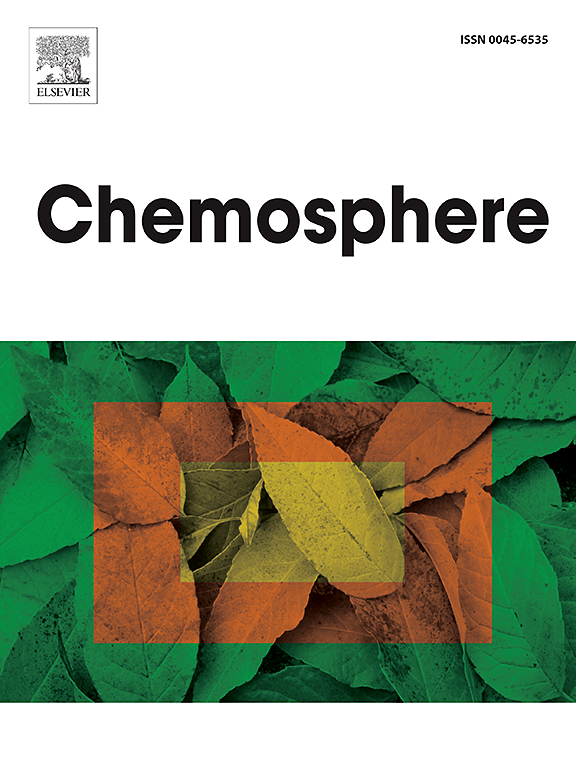瑞士日内瓦城市水循环中的微塑料检测和表征:评估供应网络的影响
IF 8.1
2区 环境科学与生态学
Q1 ENVIRONMENTAL SCIENCES
引用次数: 0
摘要
微塑料(MPs)越来越多地在水生环境中被检测到,由于其持久性、流动性和对生态系统和人类健康的潜在风险,它们日益受到关注。本研究旨在调查瑞士日内瓦城市水循环中MPs (>20 μm)的存在。评估范围包括大水量(50-2000升)的原水来源(地下水和地表水)、饮用水处理、供水网络和三个污水处理厂的流出物。在这些相互连接的系统中测定MPs浓度、大小分布和化学成分。采样和分析遵循严格的质量保证协议,符合当前的MP分析指南和标准。采用傅里叶变换红外光谱(FTIR)对MPs进行表征。日内瓦主要的传统饮用水处理厂(服务于大约500,000名消费者)显示出很高的去除效率,将原水中的MPs浓度从640±292 MP/m3降低到处理后(包括混凝、砂过滤、臭氧化和颗粒活性炭过滤)的10±6 MP/m3,去除效率为97±3%。地下水样品MPs浓度较低(8±7 MP/m3)。而饮水管网(DWSN)对MPs浓度的增加有促进作用,东段为27±37 MP/m3,西段为23±19 MP/m3。来自污水处理厂(WWTPs)的出水浓度最高,平均为5829±5108 MP/m3。这项研究强调了全周期监测的重要性,并支持在城市水循环的所有阶段改进缓解战略的必要性。本文章由计算机程序翻译,如有差异,请以英文原文为准。

Microplastics detection and characterisation in the urban water cycle of Geneva, Switzerland: Assessing the supply network impacts
Microplastics (MPs) are increasingly detected in aquatic environments and are a growing concern due to their persistence, mobility, and potential risks to ecosystems and human health. This study aims to investigate the presence of MPs (>20 μm) across the urban water cycle of Geneva (Switzerland). The scope of the assessment includes large water volumes (50–2000 L) of raw water sources (groundwater and surface water), drinking water treatment, water supply network, and effluents of three wastewater treatment plants. MPs concentrations, size distributions, and chemical compositions were determined across these interconnected systems. Sampling and analysis followed a strict quality assurance protocol aligned with current MP analysis guidelines and standards. Fourier-transform infrared spectroscopy (FTIR) was used to characterise MPs.
Geneva's main conventional drinking water treatment plant (serving approximately 500,000 consumers) showed high removal efficiency, reducing MPs concentrations from 640 ± 292 MP/m3 in raw water to 10 ± 6 MP/m3 after treatment (including coagulation, sand filtration, ozonation and granular activated carbon filtration), demonstrating a removal efficiency of 97 ± 3 %. Groundwater samples showed low concentration of MPs (8 ± 7 MP/m3). However, the drinking water supply network (DWSN) contributed to an increase of MPs concentration, with values equal to 27 ± 37 MP/m3 in the eastern section and 23 ± 19 MP/m3 in the western section. Effluents from wastewater treatment plants (WWTPs) exhibited the highest concentrations, averaging 5829 ± 5108 MP/m3.
This study highlights the importance of full-cycle monitoring and supports the need for improved mitigation strategies across all stages of the urban water cycle.
求助全文
通过发布文献求助,成功后即可免费获取论文全文。
去求助
来源期刊

Chemosphere
环境科学-环境科学
CiteScore
15.80
自引率
8.00%
发文量
4975
审稿时长
3.4 months
期刊介绍:
Chemosphere, being an international multidisciplinary journal, is dedicated to publishing original communications and review articles on chemicals in the environment. The scope covers a wide range of topics, including the identification, quantification, behavior, fate, toxicology, treatment, and remediation of chemicals in the bio-, hydro-, litho-, and atmosphere, ensuring the broad dissemination of research in this field.
 求助内容:
求助内容: 应助结果提醒方式:
应助结果提醒方式:


